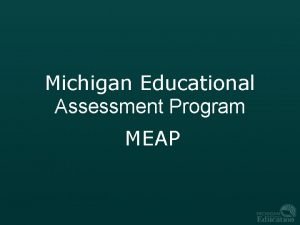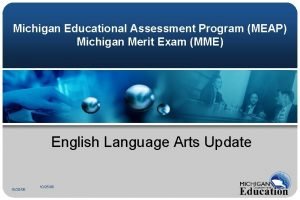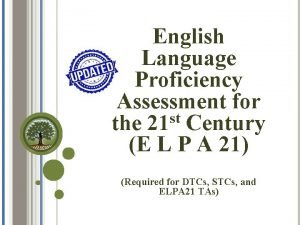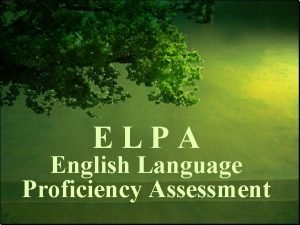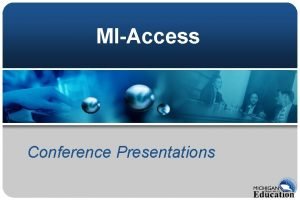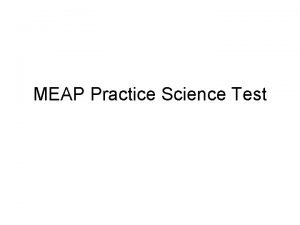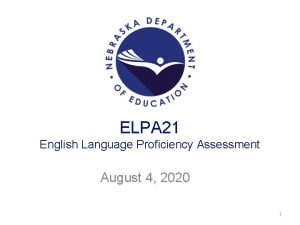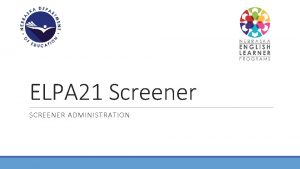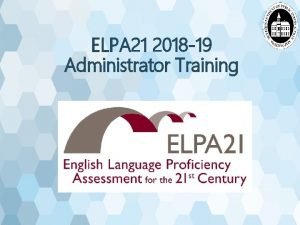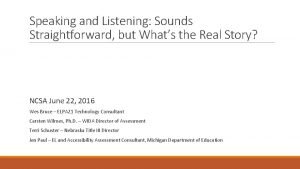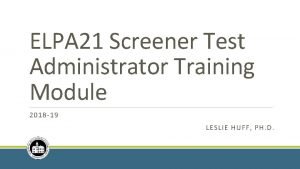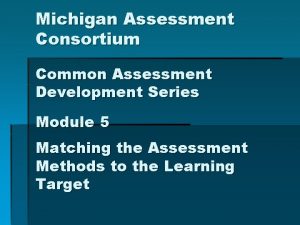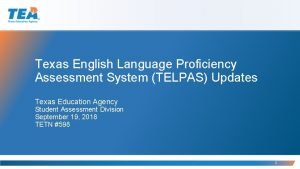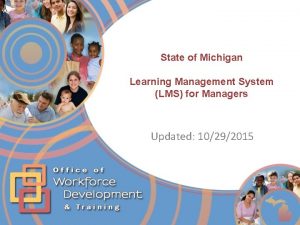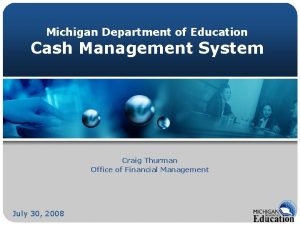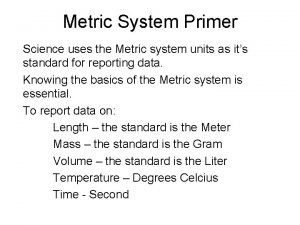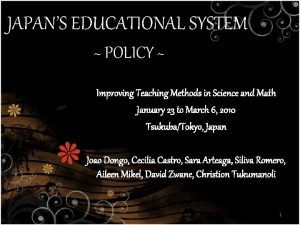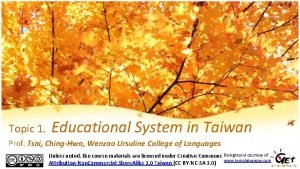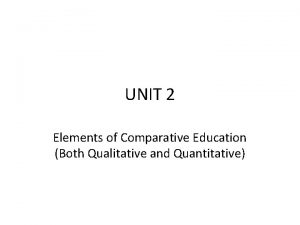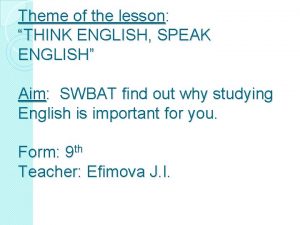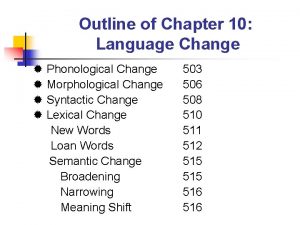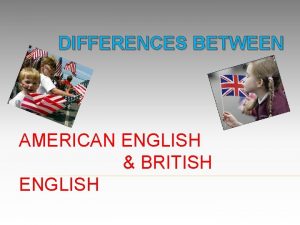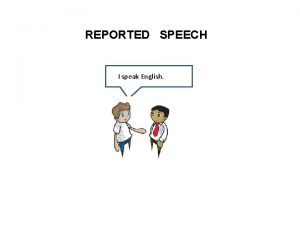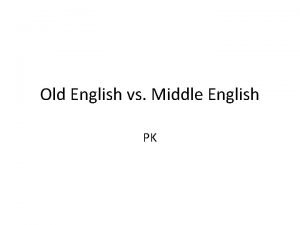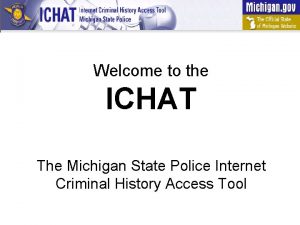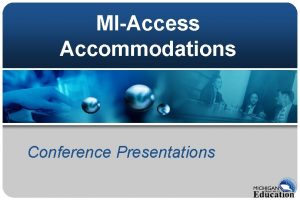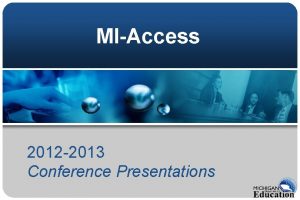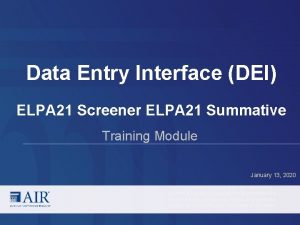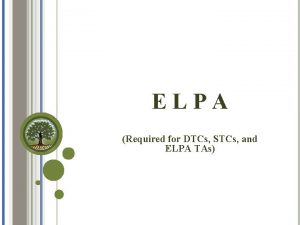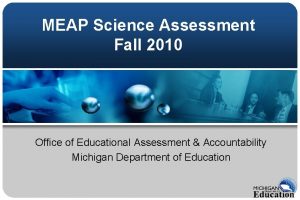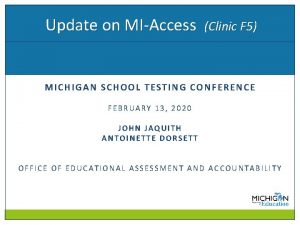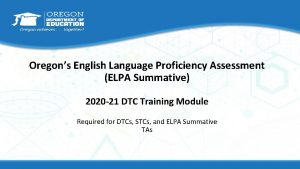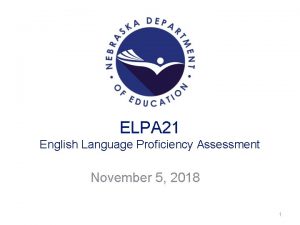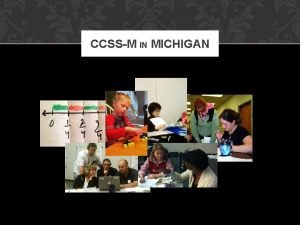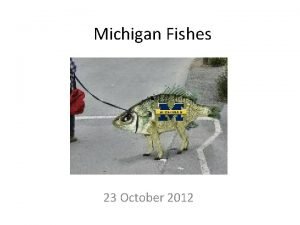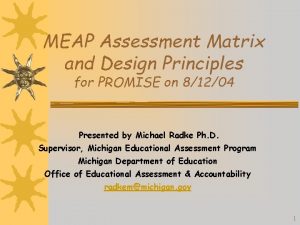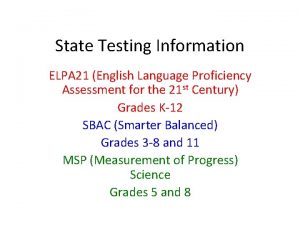Michigan Educational Assessment System MEAP MIAccess ELPA English











































- Slides: 43

Michigan Educational Assessment System (MEAP, MI-Access, ELPA) English Language Arts

ELA Test Development • Items written by Michigan teachers • Items (and selections) reviewed by: Teachers from across state during field reviews Bias Review Committee Content Review Committee • Items field tested during operational testing window • Items reviewed by Committees after data from field testing received • Tests are built by contractor and MDE staff from items that have survived this extensive review process 2

Reading: Grades 3 -8 Paired Reading Selections • Text 1 (8 multiple-choice items) • Text 2 (8 multiple-choice items) • Cross-text (6 multiple-choice items) *Field testing (1 short-answer constructed response item for each selection for use on operational test in 2009) 3

Reading: Grades 3 -8 Independent Reading Selection • Text 3 (8 multiple-choice items) Total = 30 points Selections include both narrative and expository text 4

Reading Domains Assessed Word Study Narrative Text Informational Text Comprehension 5

Writing: Grades 3 -8 Writing from Knowledge and Experience • 6 -point holistic rubric • Students choose genre, format of response • Two pages maximum • No resources • Scored as first draft, not polished response 6

Writing: Grades 3 -8 Student Writing Samples • Peer response to one Student Writing Sample (4 point rubric) • 13 multiple-choice revising and editing items from two separate Student Writing Samples • Half page maximum 7

Writing: Grades 3 -8 • No resources • Scored as first draft, not polished response • Need to increase number of multiple-choice items for Student Writing Samples in order to obtain more stable scores. Total = 23 points 8

Writing Domains Assessed Genre Process Style Grammar and Usage Spelling 9

Field Testing • Necessary to field test future items during operational test in order to build future tests. • MEAP releases 50% of items online • Important that data collected from field tests be valid. 10

ELA Assessment Schedule Session 1: Session 2: Session 1, Makeup: Session 2, Makeup: Thursday, October 16 Tuesday, October 21 Wednesday, October 22 Monday, October 27 Makeup as needed: Wednesday, October 29 & 30 *Approximately 120 -140 minutes each day; a. m. and p. m. 11

Michigan’s Alternate Assessments • Based on alternate achievement standards. • Michigan’s Grade Level Content Expectations and Benchmarks have been extended to reflect the appropriate depth, breadth, and complexity for students with the most significant cognitive disabilities; – Extended Grade Level Content Expectations (ELGCE) and Extended Benchmarks (EB) 12

MI-Access Assessments • Functional Independence (FI) Have or function as if they have mild cognitive impairment • Supported Independence (SI) Have or function as if they have moderate cognitive impairment • Participation (P) Have or function as if they have severe cognitive impairment 13

Functional Independence Word Recognition • Students answer multiple-choice items that measure their ability to access or recognize highly familiar and frequently encountered words in print. 14

Functional Independence Text Comprehension • Students access three types of passages: narrative, informational, and functional. Students answer multiple choice items that measure their comprehension skills. 15

Functional Independence Expressing Ideas • Students respond to a prompt by writing, drawing, dictating, or using a combination of the three response modes. Responses are scored according to a 4 -point holistic rubric. 16

Participation and Supported Independence (P/SI) • Designed to measure a student’s knowledge of English language arts in meaningful contexts while acknowledging that student may require some level of assistance to do so. 17

P/SI • MI-Access P/SI ELA assessments cover much of the same content as FI, but content is reduced in depth, breadth and complexity. • Example: Instead of assessing a student’s ability to decode print, these assessments measure a student’s ability to access information. 18

P/SI Universal design – Developed in such a way that the need for accommodations is significantly reduced, if not eliminated, by removing barriers to accessing the assessment to demonstrate what students know related to ELA. 19

P/SI Item Format Selected Response Items • Answer choices are presented in the form of graphics on 8 -1/2” x 11” picture cards that students must view and respond to in order to answer the question. The pictures cards must be presented twice, and the student must correctly respond twice for each item. 20

Sample Artwork 21

P/SI Item Format Activity Items • Designed to reflect classroom activities with which students should be familiar • Provide a performance context in which specific ELA EGLCEs can be assessed 22

23

P/SI ELA Components Word Study: • Students are asked to complete assessment items that measure their ability to access or recognize highly familiar and frequently encountered words in print, a picture, or actual object representing the printed words. 24

P/SI ELA Components Comprehension: • Students are asked to complete assessment items that allow them to access and comprehend various forms of information that are based on the three adult life contexts. 25

P/SI ELA Components Expressing Ideas: • Students are asked to complete assessment items that provide opportunities to express their ideas by writing, drawing, dictating, gestures, or using a combination of response modes. 26

Scoring P/SI Assessments • Two people observe and score the items: Primary Assessment Administrator, and Shadow Assessment Administrator • Record score point or condition code for each selected-response or activity item observed • Transferred to student’s answer document. Final score is the PAA and SAA scores added together. • Supported Independence – 2 -point rubric • Participation – 3 -point rubric 27

Released Items • Released item booklets are available online. • There is a booklet for each population and at each level: – FI: Grades 3, 4, 5, 6, 7, 8, and 11 – P/SI: Grades 3 -5, 6 -8, 11 28

MI-Access Assessment Schedule Grades 3 -8 • October 13 – November 21 Grade 11 • February 16 – March 31 29

ELPA Reading and Writing • Items and passages written by Michigan teachers • Items and passages reviewed by: Bias/Sensitivity Review Committee Content Review Committee • Items and passages field tested during operational testing window • Items and passages reviewed by committees after data from field testing received • Test forms are built by contractor with MDE staff oversight from items and passages that have survived this extensive review process 30

ELPA Reading Passages • ELPA Passage Specifications – Written jointly by OEAA and contractor – Guides writers for length, linguistic and cognitive complexity, readability, topic appropriateness – Used by contractor during training – Aligned to BICS and CALP expectations of ability • BICS: Basic Interpersonal Communication Skills • CALP: Cognitive Academic Language Proficiency 31

ELPA Reading and Writing Items • ELPA Item Specifications – Written jointly by OEAA and contractor – Guides writers for item type, length, linguistic and cognitive complexity, response expectations, graphics, and phrasing of directions – Used by contractor during item writing training – Requires writers to align items to ELP standards 32

Types of ELPA Reading Passages • Narrative/Literary – Can feature characters, setting, sequence of events – Typically written with dialogue – Models types of comprehensible input available to English Language Learners (ELLs) during general instruction – Should allow for lexical (vocabulary), semantic (idioms), comprehensive (main idea) and pragmatic (inferential) questions 33

Types of ELPA Reading Passages • Informational/Content-Area Related – Models types of comprehensible input available to ELLs during content-area instruction – Based on math, science, or social studies – Should suppress requirement for prior knowledge in content area; can explain or introduce concept during passage – Should allow for lexical (vocabulary), comprehensive, and pragmatic (inferential) questions 34

ELPA Reading Passages • Both types featured in all Assessment Levels • Cognitive demand geared to age level • Individual multiple-choice items written to every passage • Individual passage themes or topics are not connected to each other • Passages sequenced along length and complexity 35

ELPA Writing Items • Multiple-choice section (Writing Conventions) precedes constructedresponse section (Writing) • These two sections can be administered as separate sessions to reduce testing fatigue • Writing Conventions items based on W. 1 and W. 2 – W. 1 Use conventions and formats of written English – W. 2 Use grammatical conventions of English 36

ELPA Writing Items • Writing constructed-response items based on W. 3, W. 4, W. 6, and W. 8 – W. 3 Write using appropriate vocabulary choice and variation – W. 4 Construct sentences and develop paragraphs to organize writing supporting a central idea – W. 6 Use various types of writing for specific purposes – W. 8 Use tone and voice to engage specific audiences 37

ELPA Writing Items Item Type Levels Assessed Max. Points Letter Writing I 1 Word Writing I and II 2 Sentence Writing II and III 2 Sentence Combination IV and V 2 Paragraph Writing III, IV, and V 4 Extended Response, Story I, II, and III 4 Extended Response, Essay IV and V 4 38

Scoring ELPA Writing Items • Rubrics for ELPA Writing responses developed jointly by OEAA and contractor • Michigan educators serve on Rangefinding committees – Provide definitions for exemplar student responses at different rubric score points – Provide model responses for training of contractor’s scoring staff – Helps ensure inter-rater reliability – Helps ensure appropriate expectations 39

ELPA Assessment Schedule 2009 ELPA Testing Window: Monday, March 16, 2009 to Friday, April 24, 2009 40

Tips for Improvement • Teach your curriculum year-round! • Know the GLCEs • Use the rubrics and checklists with students on a regular basis • Use the “Released Items” from the website, especially the scoring guides, for professional staff development and instruction with students (www. michigan. gov/meap) • Remind students to answer specific questions in constructed response (no evidence that question was read = 0) • Don’t “drill and kill” just before the test! 41

Contact Information Wendy Gould English Language Arts Assessment Consultant, MDE/MEAP gouldw@michigan. gov Linda Howley Interim Assessment Consultant for Students with Disabilities howleyl@michigan. gov Phil Chase ELPA Consultant chasep 2@michigan. gov 42

For more information: MEAP www. michigan. gov/meap 877 -560 -8378 MI-Access www. michigan. gov mi-access@questarai. com 888 -382 -4246 ELPA www. michigan. gov/elpa 877 -560 -8378 43
 Meap test michigan
Meap test michigan Michigan meap
Michigan meap English language proficiency assessment (elpa)
English language proficiency assessment (elpa) Elpa test
Elpa test Mi access
Mi access Oeaa baa
Oeaa baa Meap practice tests
Meap practice tests Elpa 21
Elpa 21 Elpa screener
Elpa screener Elpa21 practice test washington
Elpa21 practice test washington Wida headsets
Wida headsets Elpa training
Elpa training Hollila
Hollila Michigan assessment consortium
Michigan assessment consortium Telpas 4 point speaking rubric
Telpas 4 point speaking rubric Bureau of educational assessment
Bureau of educational assessment Lms state of michigan
Lms state of michigan Cash management system mde
Cash management system mde Metric system vs english system chart
Metric system vs english system chart Education system in spain
Education system in spain Japans educational system
Japans educational system Educational system in bulgaria
Educational system in bulgaria Integrated education
Integrated education Educational system in taiwan
Educational system in taiwan Educational system in greece
Educational system in greece Elements of comparative education
Elements of comparative education Essential elements of portfolio assessment
Essential elements of portfolio assessment Static assessment vs dynamic assessment
Static assessment vs dynamic assessment Portfolio assessment matches assessment to teaching
Portfolio assessment matches assessment to teaching English speak lesson
English speak lesson Spoken english and broken english g.b. shaw summary
Spoken english and broken english g.b. shaw summary Tumoxan
Tumoxan Who is father of english drama
Who is father of english drama Old english vs modern english
Old english vs modern english British and american word differences
British and american word differences Difference between american english and british english
Difference between american english and british english Old english vs modern english
Old english vs modern english Do you speak english reported speech
Do you speak english reported speech Middle english examples
Middle english examples Spoken english and broken english summary
Spoken english and broken english summary British and american english
British and american english Open system closed system and isolated system
Open system closed system and isolated system Digestive respiratory and circulatory system
Digestive respiratory and circulatory system Michigan state police ichat
Michigan state police ichat
